Military Campaigns
Eric governed the Duchy of Friuli from Cividale, the former Lombard capital and also residence of the Patriarch of Aquileia. Much of Eric's tenure as duke of Friuli was occupied by the task of subduing the nearby Avars. In this he was accompanied by Pepin of Italy and his own father, the margrave of Avaria. In 791, he and Pepin marched a Lombard army into the Drava valley and ravaged Pannonia, while Charlemagne marched along the Danube into Avar territory. Charlemagne left the campaigning to deal with a Saxon revolt in 792, while Pepin and Eric continued to assault the Avars' ring-shaped strongholds. The great Ring of the Avars, their capital fortress, was taken twice, and the booty was sent to Charlemagne in Aachen and redistributed to all his followers and even to foreign rulers, including King Offa of Mercia.
The Annales Laurissenses relate that in 795/6 Eric sent raiders into Pannonia under Vojnomir, duke of the Pannonian Croats. Meanwhile, he himself and Pepin, allied with the Western Avar tudun , led an attack which both forced the submission of the chief Avar khagan and led to the capture of the Hunorum Hringum, or Ring of the Avars, their chief camp. The khagan was taken to Aachen, where he accepted baptism with the name Theodorus. However, according to the Annales Fuldenses , Theodorus was assassinated by his own men when he returned to them.
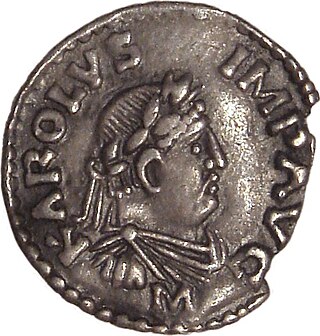
Charlemagne was King of the Franks from 768, King of the Lombards from 774, and the Holy Roman Emperor from 800, all until his death in 814. Charlemagne succeeded in uniting the majority of Western and Central Europe, and he was the first recognized emperor to rule Western Europe after the fall of the Western Roman Empire approximately three centuries earlier. Charlemagne's rule saw a program of political and societal changes that had a lasting impact on Europe in the Middle Ages.
The 790s decade ran from January 1, 790, to December 31, 799.

Year 799 (DCCXCIX) was a common year starting on Tuesday of the Julian calendar. The denomination 799 for this year has been used since the early medieval period, when the Anno Domini calendar era became the prevalent method in Europe for naming years.
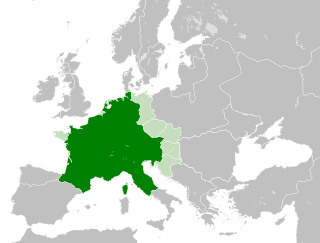
The Carolingian Empire (800–887) was a Frankish-dominated empire in western and central Europe during the Early Middle Ages. It was ruled by the Carolingian dynasty, which had ruled as kings of the Franks since 751 and as kings of the Lombards in Italy from 774. In 800, the Frankish king Charlemagne was crowned emperor in Rome by Pope Leo III in an effort to transfer the Roman Empire from the Byzantine Empire to Western Europe. The Carolingian Empire is sometimes considered the first phase in the history of the Holy Roman Empire.

Pepin, born Carloman, was the son of Charlemagne and King of Italy (781–810) under the authority of his father.

Tassilo III was the duke of Bavaria from 748 to 788, the last of the house of the Agilolfings. He was the son of Duke Odilo of Bavaria and Hitrud, daughter of Charles Martel.
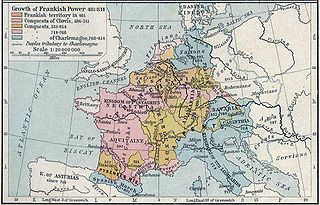
Višeslav was one of the first dukes in Dalmatian Croatia. He ruled from c. 785 to c. 802.

Saint Paulinus II was a priest, theologian, poet, and one of the most eminent scholars of the Carolingian Renaissance. From 787 to his death, he was the Patriarch of Aquileia. He participated in a number of synods which opposed Spanish Adoptionism and promoted both reforms and the adoption of the Filioque into the Nicene Creed. In addition, Paulinus arranged for the peaceful Christianisation of the Avars and the alpine Slavs in the territory of the Aquileian patriarchate. For this, he is also known as the apostle of the Slovenes.
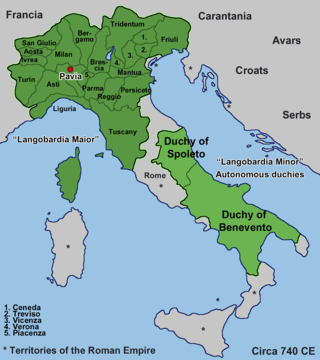
The Duchy of Friuli was a Lombard duchy in present-day Friuli, the first to be established after the conquest of the Italian peninsula in 568. It was one of the largest domains in Langobardia Major and an important buffer between the Lombard kingdom and the Slavs, Avars, and the Byzantine Empire. The original chief city in the province was Roman Aquileia, but the Lombard capital of Friuli was Forum Julii, modern Cividale.
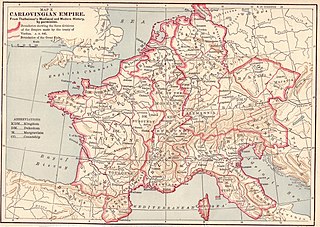
The March of Friuli was a Carolingian frontier march, established in 776 as the continuation of the Lombard Duchy of Friuli, established against the Slavs and Avars. It was ceded to the Duchy of Bavaria as the March of Verona in 952. Its territory comprised parts of modern-day Italy, Slovenia and Croatia.
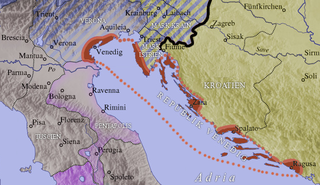
The March of Istria was originally a Carolingian frontier march covering the Istrian peninsula and surrounding territory conquered by Charlemagne's son Pepin of Italy in 789. After 1364, it was the Istrian province of the Habsburg monarchy, the Austrian Empire and Austria-Hungary.

The March of Pannonia or Eastern March was a frontier march of the Carolingian Empire, named after the former Roman province of Pannonia and carved out of the preceding and larger Avar March.
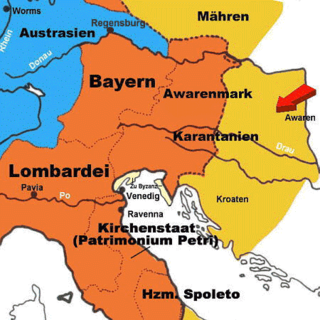
The Avar March was a southeastern frontier province of the Frankish Empire, established after successful Frankish campaigns and conquests of Avarian territories along the river Danube, to the east from the river Enns, in what is today Lower Austria and northwestern Hungary. Since the Frankish conquest in the late 8th century, there were several administrative changes in those regions. Territory along the river Danube, from the river Enns to the Vienna Woods, was ruled directly, as a frontier extension (march) of the Frankish Bavaria, while regions further to the east, up to the river Rába, were initially designated to remaining Avarian princes, under the Frankish supreme rule. During the 820s and 830s, additional administrative changes were made in the wider region of Frankish Pannonia, inhabited mainly by Pannonian Slavs. Territories of the remaining Avarian princes were fully incorporated, and Avars eventually disappeared from the region.

Vojnomir, Voynomir or Vonomir I was a Slavic military commander in Frankish service, the duke of Slavs in Lower Pannonia, who ruled from c. 790 to c. 800 or from 791 to c. 810 over an area that corresponds to modern-day Slavonia, Croatia.

The siege of Trsat was a battle fought over possession of the town of Trsat in Liburnia, near the Croatian–Frankish border. The battle was fought in the autumn of 799 between the defending forces of Dalmatian Croatia under the leadership of Croatian duke Višeslav, and the invading Frankish army of the Carolingian Empire led by Eric of Friuli. The battle was a Croatian victory, and the Frankish commander Eric was killed during the siege.
The Epistola de litteris colendis is a well-known letter addressed by Emperor Charlemagne to Abbot Baugulf of Fulda, probably written sometime in the late 780s to 800s (decade), although the exact date is still debatable. The letter is a very important witness to the Carolingian educational reforms during the Carolingian Renaissance from the late 8th century to the 9th century. The letter shows Emperor Charlemagne's interest in promoting learning and education within his empire.
Gerold was a franconian nobleman who served the Frankish King, Charlemagne, as Margrave of the Avar March and Prefect of Bavaria in what is now South-Eastern Germany. Gerold played a significant role in the integration of Bavaria into the Frankish Kingdom during Carolingian expansion in the late 8th, and early 9th centuries. Gerold both aided the continuity of Agilofing rule of Bavaria, as well as took steps to integrate Bavarians into the wider scope of the Frankish Kingdom. Gerold was related both to the Agilofing family, the ruling class of Bavaria, as well as the Carolingian family. The Agilofings had ruled Bavaria since Duke Garibald I in 548. Gerold was born into the Agilofings, and his sister Hildegard was married to Charlemagne in 771. From these familial connections, he was appointed Prefect of Bavaria following the deposition of Duke Tassilo III in 788. Gerold was heralded as a superb military commander, giving rise to his promotion to Prefect as a defender of the eastern border of the Frankish Kingdom. In 799, Gerold is said to have fallen in battle against the Avars, shortly after the same Avars killed his ally, Eric, Duke of Friuli, through treachery.
Spanish Adoptionism was a Christian theological position which was articulated in Umayyad and Christian-held regions of the Iberian peninsula in the 8th- and 9th centuries. The issue seems to have begun with the claim of archbishop Elipandus of Toledo that – in respect to his human nature – Jesus Christ was adoptive Son of God. Another leading advocate of this Christology was Felix of Urgel. In Spain, Adoptionism was opposed by Beatus of Liebana, and in the Carolingian territories, the Adoptionist position was condemned by Pope Hadrian I, Alcuin of York, Agobard, and officially in Carolingian territory by the Council of Frankfurt (794).
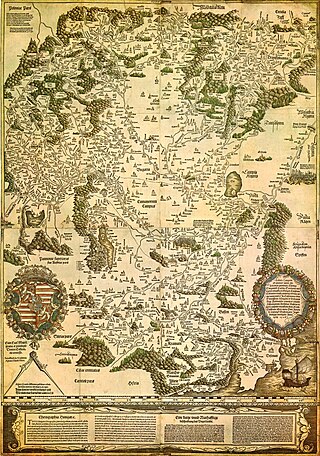
The timeline of Hungarian history lists the important historical events that took place in the territory of Hungary or are closely connected to the history of the country. The subsequent events encompass the timeline spanning from Classical Antiquity through the High Middle Ages, specifically up to the 1030s.

The Avar Wars were fought between Francia and the Avar Khaganate in Central Europe from 788 to 803, and ended with the Frankish conquest of the khaganate's western regions. The first conflicts between the Avars and the Franks occurred in the 560s, shortly before the Avar conquest of the Pannonian Basin. Armed conflicts between the two powers were not unusual during the following centuries.













